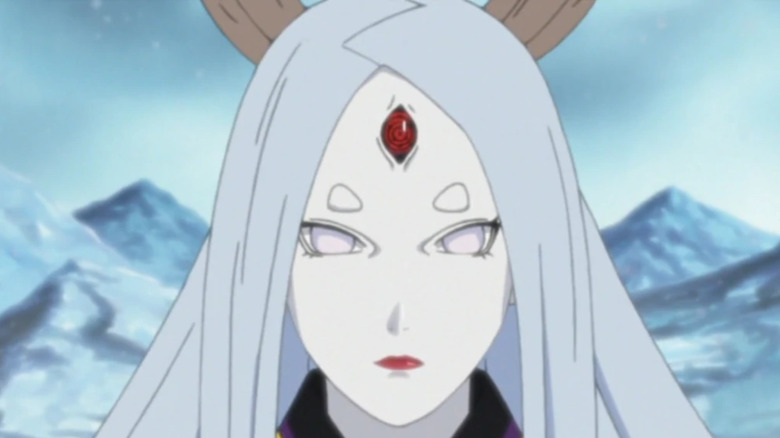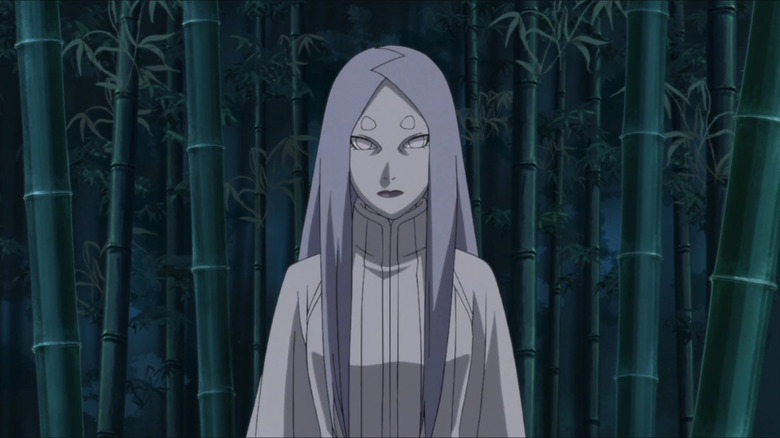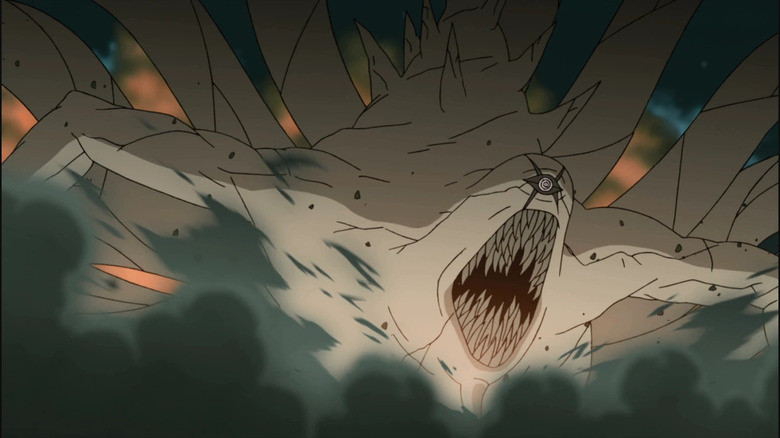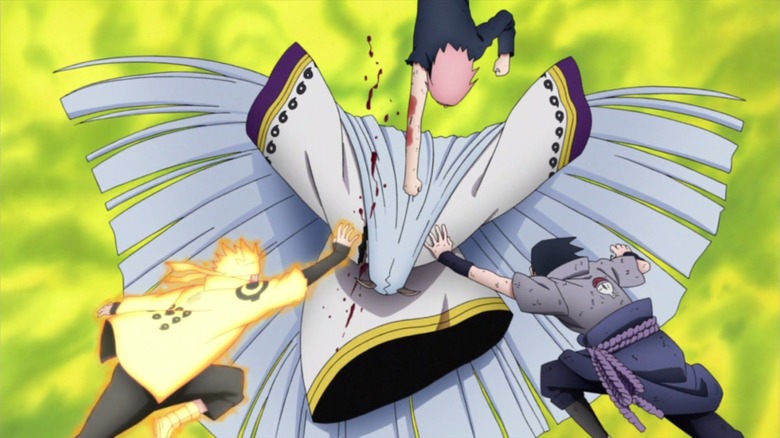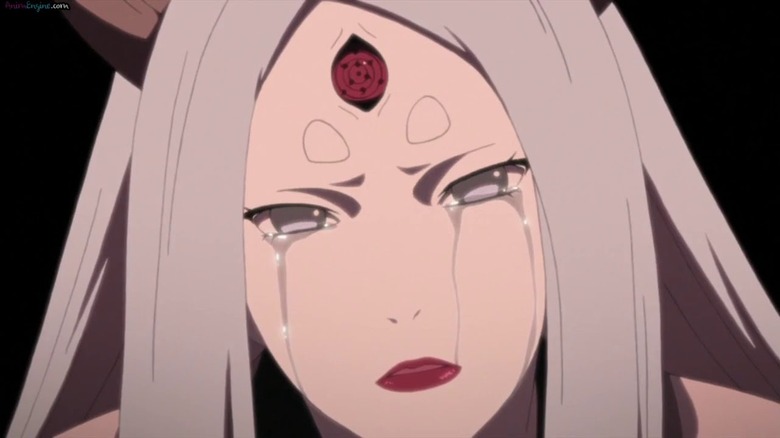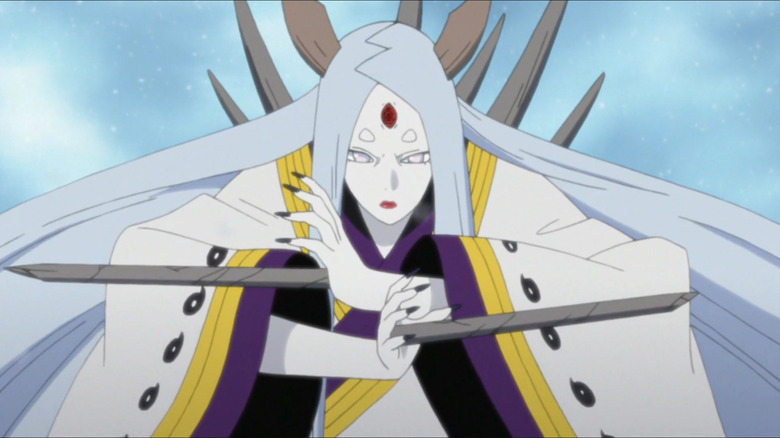The Untold Truth Of Princess Kaguya Otsutsuki From Naruto
Across its hundreds of chapters and episodes, "Naruto" presented several great contenders for the series' inevitable main antagonist. From the snake-like rogue shinobi, Orochimaru, to the cynical Rinnegan user Pain, and finally the devilish Madara Uchiha, all of these characters could have been potential antagonists. Furthermore, it really seemed as if "Naruto" author Masashi Kishimoto had planned for Madara to fill that role. That is, until he was betrayed by Black Zetsu, who subsequently reveals that he had been working for an ancient and grave threat the whole time, and that Madara had unwittingly been playing into the hands of the true villain, Princess Kaguya Otsutsuki, whom he had just released from generations of being sealed away.
A godlike being from the alien Otsutsuki Clan, Kaguya appeared just to prove how small-potatoes Naruto and other shinobi really were in the grand scheme of things. As the originator of all chakra on the planet, courtesy of the God Tree's fruit, Kaguya far outmatched anything Naruto or Sasuke could drum up on their own. And with the Infinite Tsukuyomi already in position, she seemed primed to lock humanity in an infinite dream so that she might reign supreme once more. Thankfully, Naruto and Sasuke manage to seal her away again (this time for good) in just a few chapters. Despite her swift exit and entrance, however, there's a lot more to Kaguya than meets the eye.
Kaguya is based on a Japanese fairytale
Kaguya is more than just Kishimoto's brain-child. She's actually based on a piece of classical Japanese folklore dating back to the 10th Century CE known as "Taketori Monogatari," or "The Tale of The Bamboo Cutter" (via Ohio State University) It tells the story of a woman named Kaguya-hime, who is found as an infant inside the stalk of a bamboo plant. She possesses strange powers and is beautiful, but despite this, she rejects any and all suitors, including the Emperor. In time, she reveals that she is actually from the moon, and that her fellow Moon-dwellers will one day return to take her home, which they eventually do.
The story of this Kaguya holds many similarities with the one from "Naruto" beyond just a name. Like the fairytale Kaguya, Kaguya Otsutsuki is a celestial being with powers beyond that of a human. Both characters are also depicted with rabbit ears, which in "Naruto" are represented by Kaguya's prominent horns (via Naruto wiki). Likewise, "Naruto" Kaguya's origin, where she falls in love with a human Emperor after arriving on Earth, resembles the fairytale character's relationship with the Emperor of Japan. In the original story, this ends with the Japanese Emperor burning his mementos of her atop Mt. Fuji, creating the pillar of smoke which the volcano is known for. In "Naruto," however, this ends with Kaguya using the God Tree to turn her husband (and the rest of humanity) into White Zetsu.
Kaguya is basically a Moon goddess
However, that's only the beginning of Kaguya's callbacks to "Taketori Monogatari." The resemblance between both characters is also shown through their connections to plant life and the Moon. In "Naruto," the "bamboo" is the God Tree, which Kaguya eventually combines with to become the Ten Tails, and which her children, Hagoromo and Hamura eventually seal away, creating the Moon in the process.
While the chakra of the Ten Tails was sealed within Hagoromo before being split into the various Tailed Beasts, the physical husk of the creature became the Moon. In order to ensure that Kaguya could never return, Hamura chose to stay on the Moon, where he started his own offshoot of the Otsutsuki Clan. Unfortunately, Kaguya's will managed to survive through Black Zetsu, who managed to manipulate world events so that Kaguya might one day return.
Essentially, this makes Kaguya a Moon goddess of sorts. Not only is her physical form the Moon itself, but her descendants go on to populate the natural satellite. While the rest of the Otsutsuki Clan are definitely comparable to gods, Kaguya remains special in that she is so far the only one that actually embodies a natural phenomenon.
Fans were never overly-fond of Kaguya
Though her origins as a character are certainly interesting, it's fair to say that Kaguya's introduction into "Naruto" was a bit sudden. At that point, Kishimoto had done a great job at building Madara up as the true antagonist. He was manipulative and powerful, but had an understandable motivation in using the Infinite Tsukuyomi to attain world peace. This made him a pretty engaging final threat before Naruto and Sasuke finally settled their own differences, but all of that practically went out of the window when Kaguya arrived, and fans knew it.
"She could have been a cool villain if everything about her wasn't rushed as hell," wrote one fan on Reddit. "Madara was a better villain because he was actually built up properly and all that jazz. I can even get past the whole thing with Kaguya just popping out of nowhere if the fight with her wasn't so rushed as well."
After the finale of "Naruto," Kaguya's entrance into the series became a controversial topic among fans. Many, like the aforementioned Reddit user, felt that she was stuck into "Naruto" without proper planning and buildup, and publications like GameRant even wrote articles criticizing her place in the story. Even so, Kaguya does have some traction within the fanbase, and overall her inclusion in the story did have some positive effects on "Naruto."
Nobody knows exactly why Kishimoto created her
Because Kaguya's introduction seemed so out of place to many fans, it's understandable that they would question why Kishimoto even included her. Again, Madara already seemed like a pretty serviceable main villain for the series, so why would Kishimoto ruin that by including Kaguya?
Well, one possible explanation that fans have come up with is that Kishimoto created Kaguya because he had made Madara too strong for Naruto and Sasuke to plausibly defeat. Many fans even back this up with a (and we really need to stress this) unsubstantiated rumor (via Quora), claiming that Kishimoto admitted to writing himself into a corner with Madara, and invented Kaguya as a way to get rid of him.
Though no real evidence of Kishimoto saying this exists, it would technically explain how random Kaguya is. Others still believe that Kishimoto intended for Kaguya to do more, but had to cut the series short at the urging of his editor. Either way, there's no solid evidence of either of these explanations, and truthfully nobody but Kishimoto knows for certain exactly why Kaguya was introduced in such a manner.
Her main purpose seemed to be filling out lore
If fans were to settle on a reason for Kaguya's introduction, the best thing they can work from is "Naruto" itself. Therefore, based on what's shown in the manga and anime, it's pretty clear that at least one of Kaguya's purposes was to fill out a lot of unanswered questions surrounding the lore of "Naruto." This is something Madara also did well, as his backstory fleshed out the reasons why Hidden Villages, the Uchiha Clan, and shinobi in general, all exist in their current state. Kaguya's origins, on the other hand, explains how chakra and the Tailed Beasts all come into play.
As an Otsutsuki, it was Kaguya's job to sacrifice herself so that the God Tree might impart one of its chakra fruit to be eaten by another member of her clan. For a number of unknown reasons, however, Kaguya refuses to do this, and instead sacrifices her partner, and Isshiki Otsutsuki takes the fruit for herself. She becomes the original chakra wielder of the "Naruto" universe, and it is through her half-human sons that chakra disseminates throughout the human population.
On top of all that, the Otsutsukis would later become major antagonists through much of the sequel series, "Boruto: The Next Generation." Without Kaguya's introduction, the writers of "Boruto" would never have had the material to extend the franchise further than Naruto and Sasuke's stories.
